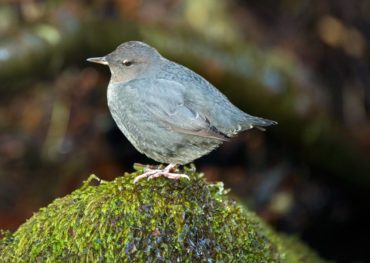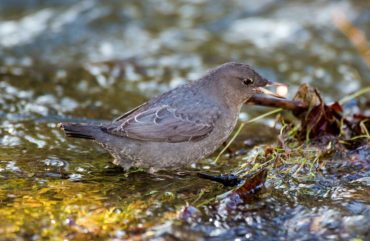
Songbirds are not just frequent visitors to gardens and birdhouses. They are everywhere. Some species, like the dark-eyed junco, are ubiquitous, adapting to various environments. But others have special habitat requirements. For example, marsh wrens need marshes and sagebrush sparrows need sagebrush.
A songbird splashing in shallow water is a common sight. But is it normal for a songbird to go swimming in a swiftly moving stream? For one species, it’s the only life it knows. That bird is North America’s only aquatic songbird, the remarkable American dipper.
Those not familiar with the lifestyle of the bird formerly known as a “water ouzel” may be surprised at what they see when viewing an American dipper for the first time. One woman, upon seeing her first dipper, cried out to a park ranger that a bird was trying to kill itself by leaping into a creek. The truth is, the bird was just looking for a snack.
American dippers feed primarily upon aquatic insects and larvae, fish eggs and small fish. Aided by long legs and claws, they forage underwater by walking along the streambed of icy creeks and mountain rivers, picking tasty morsels from the pebbles. Although they do not have webbed feet, dippers are skilled swimmers and use their wings as propellers.
To survive in frigid water, dippers possess an array of unique features not found on other songbirds. They have a thick layer of waterproof down for insulation and glands that secrete an oily wax to increase the water resistance of their feathers.
Like goggles, a third eyelid allows dippers to see underwater. Special scales slide over the nostrils when they dive. With a capacity for high oxygen levels, dippers can hold their breath up to 15 seconds while foraging beneath the surface.
In between dives, the American dipper stands on a boulder that is being pounded by the raging current. It is from this position that the dipper acquires its name. While perched, dippers are known to constantly bob, or dip, up and down. The dipping may be a form of communication. When alarmed, a dipper increases its bobbing.

American dippers build mossy dome nests on banks and rocky streamside ledges. Behind a waterfall is an ideal nest site. Both parents care for the brood of four or five chicks.
The dipper’s high-pitched song is loud enough to be heard above the rushing water. About the size of a blackbird, the dipper lacks spectacular plumage. Its slate-gray body and slightly brown head are somewhat drab in appearance. A plump shape and short tail enhance the dipper’s endearing personality.
The American dipper’s unique behavior makes it a fan favorite among birders. John Muir, naturalist and pioneer of conservation, was particularly fond of the American dippers he watched in Yosemite National Park.
In his field notes, he once wrote, “Not web-footed, yet he dives fearlessly into foaming rapids, seeming to take the greater delight the more boisterous the stream.” As Muir observed, dippers seem to enjoy the thrills of life on the river’s edge, making them especially fun to watch.
Not found in central or eastern states, the American dipper is a bird of the West. As North America’s only species of dipper (there are five in the world), it’s often high on the list of birds that visitors to Washington hope to see.
Another interesting fact about American dippers is that when nature calls, they will not answer while in the water. Instead, they retreat to the shore or an exposed rock or log.
Why is this worth mentioning? By leaving their calling cards, American dippers tell us where they have been, which can make all the difference when trying to locate one.
When scanning probable dipper habitat, if the bobbing bird is missing in action, look for droppings on the rocks and logs in the stream. If there is none, continue the search somewhere else.
If you see the whitewash, but no bird, be patient. Dippers fly low over the water, so one may soon swoop in.
Like the salmon that inhabit their ecosystem, American dippers are indicator species. Stream pollutants such as fertilizers, pesticides and oil kill aquatic insects. Healthy streams produce prey for both salmon and dippers. Therefore, conservation efforts that benefit salmon are good for dippers too.
Late fall and winter offer the best viewing of American dippers in West Sound, as the creeks are filled with rainwater. Any rocky stream offers the possibility of seeing one, but the most reliable local spots include the salmon viewing areas along Chico and Dickerson creeks near Bremerton and Fish Park in Poulsbo.
If you like two-for-one deals, go see the annual migration of salmon as they swim upstream to their spawning grounds. And while you are there, keep an eye out for West Sound’s one-of-a-kind aquatic songbird.























Comments